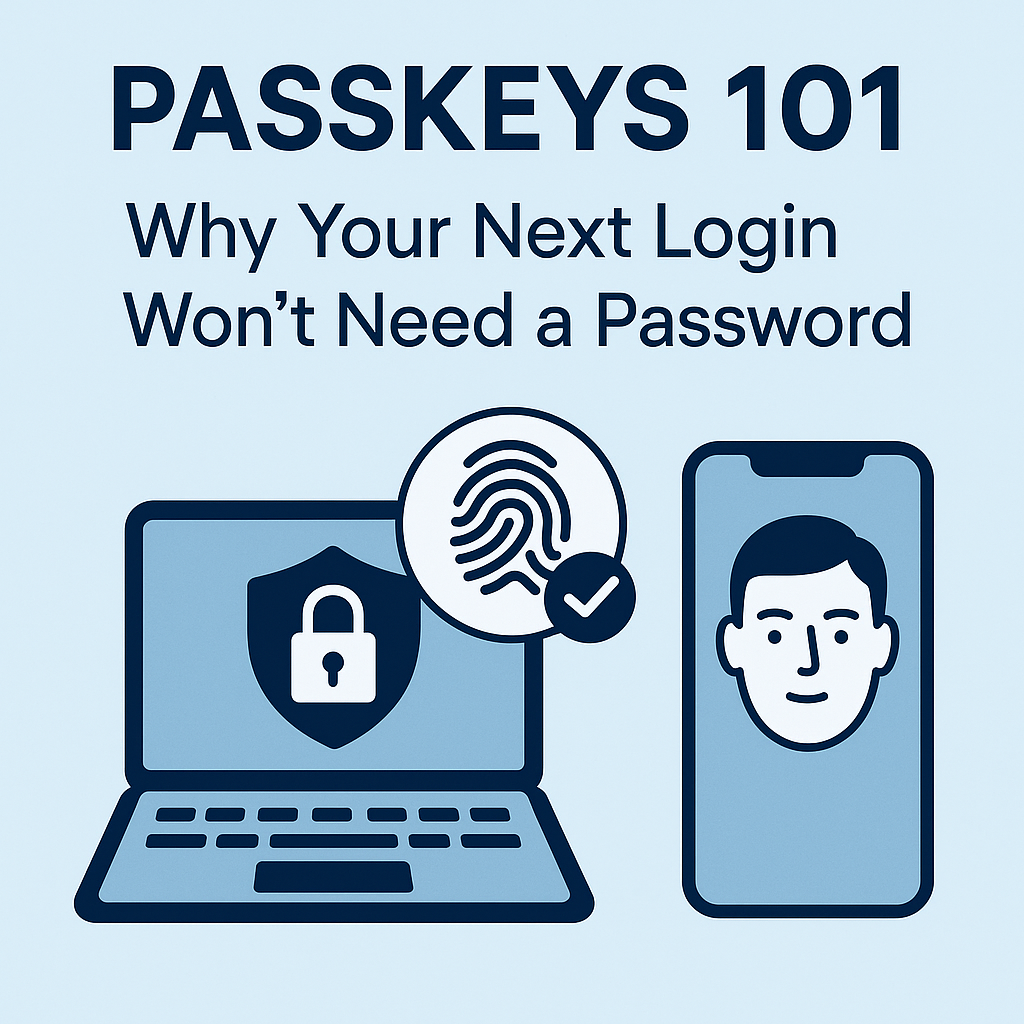
The Cybersecurity Problem with Password
Passwords are the weakest link in most cybersecurity systems. According to Verizon’s 2024 Data Breach Report, over 80% of breaches involve stolen or reused passwords (Verizon, 2024).
Here’s why passwords are so risky:
- People reuse them across accounts
- Phishing tricks users into revealing them
- Data breaches leak them in bulk
- Many passwords are weak or predictable
Security experts have long warned that password-based authentication is outdated. That’s where passkeys come in — offering phishing-proof, leak-resistant, and user-friendly login security.
What Are Passkeys and Why Are They Safer?
Passkeys are based on public key cryptography, part of the FIDO2/WebAuthn standard. Unlike passwords, passkeys never leave your device — so they can’t be intercepted or reused.
Here’s how they protect you:
- A unique private key stays securely on your phone or computer
- A public key goes to the website or app
- When you log in, the site sends a challenge that only your device can answer
- You verify with Face ID, fingerprint, or device PIN
Since no shared secret is transmitted, man-in-the-middle attacks and credential stuffing don’t work.
As the FIDO Alliance explains, “Passkeys can’t be phished, leaked, or guessed” (FIDO Alliance, 2023).
Big Tech Has Gone All-In
Security-focused companies have adopted passkeys as a default:
- Google made passkeys the default login method in 2024
- Apple stores passkeys securely in iCloud Keychain
- Microsoft integrates passkey login across Windows and Azure
With support in Chrome 119+, Safari 18+, and Edge, this is now a mainstream security solution — not just a tech preview.
Security Advantages at a Glance
| Threat Type | Passwords Are Vulnerable | Passkeys Are Secure |
|---|---|---|
| Phishing | ✅ Easily tricked | ❌ Cryptographically locked |
| Database breaches | ✅ Stored centrally | ❌ Private key never leaves your device |
| Credential reuse attacks | ✅ Very common | ❌ Every passkey is unique |
| Brute-force attacks | ✅ Many weak passwords | ❌ No reusable string to guess |
(Source: FIDO Alliance, 2023; ENISA, 2024)
How to Set Up a Passkey in 5 Minutes
🔐 On Google Accounts
- Visit: g.co/passkeys
- Click Start using passkeys
- Choose a supported device (e.g. Android, iPhone, or Chromebook)
- Verify with Face ID, fingerprint, or PIN
- Done — no password needed for future logins!
Google recommends setting up multiple devices or adding a security key as a fallback (Google, 2024).
🍏 On Apple ID
- Go to Settings > Apple ID > Password & Security
- Tap Passkeys
- Select Set Up
- Use Face ID or Touch ID to verify
- iCloud will sync it across your Apple devices
You can now use your Apple device to log in to compatible websites and apps — securely and instantly.
What Happens If You Lose Your Device?
One concern in cybersecurity is recoverability. Passkeys handle this smartly:
- iCloud and Google Account backup ensures recovery
- You can register multiple passkey devices
- Some platforms offer hardware security keys (like YubiKey) as additional backup
Recovery processes are secure, identity-verified, and designed to prevent takeover attacks (ENISA, 2024).
Where You Can Use Passkeys Today
Hundreds of major services already support passkeys:
- Google (Gmail, YouTube, Drive)
- Apple (iCloud, App Store)
- Microsoft (Outlook, Office 365)
- GitHub
- PayPal
- eBay
- DocuSign
- More being added every month!
Check if your services allow passkey login — it’s often found under “Security Settings” or “Sign-in Options”.
What This Means for the Future of Cybersecurity
Passkeys aren’t just a convenience — they are a foundational shift in digital identity.
Security professionals now recommend:
- Moving teams and personal accounts to passkeys
- Using passkeys with hardware tokens for high-risk systems
- Educating users on phishing-resistant authentication
As adoption grows, passkeys could drastically reduce credential-based attacks, which are still the number one cause of breaches (Verizon, 2024).
Takeaway: Start Small, Secure Everything
Setting up passkeys is quick and painless. You can:
- Replace weak passwords on key accounts
- Reduce phishing risk to near zero
- Be part of the move toward a safer internet
Cybersecurity starts with strong identity — and passkeys deliver exactly that.
References
- Apple. (2024). Use passkeys to sign in to apps and websites. https://support.apple.com/en-us/HT213305
- ENISA. (2024). Identity and Access Management Guidelines. https://www.enisa.europa.eu/publications/iam-guidelines
- FIDO Alliance. (2023). The passwordless future is here. https://fidoalliance.org/passkeys/
- Google. (2024). Sign in with a passkey. https://g.co/passkeys
- Verizon. (2024). Data Breach Investigations Report (DBIR). https://www.verizon.com/business/resources/reports/dbir/
